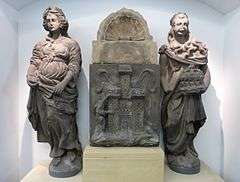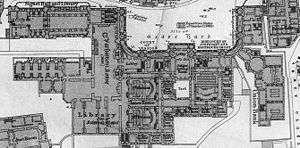Parliament House, Edinburgh
Parliament House in Edinburgh, Scotland is a complex of several buildings housing the Supreme Courts of Scotland. The original building was home to the pre-Union Parliament of Scotland from 1639 to 1707. It is located in the Old Town, just off the High Street section of the Royal Mile, beside St Giles Cathedral.
Parliament Hall
The oldest part of Parliament House is Parliament Hall, which the Town Council of Edinburgh, at its expense, had built as a permanent home for the Parliament of Scotland, and as such is the oldest extant purpose-built parliamentary building in the British Isles.[1] It was completed in 1641 to the design of James Murray.[2] The main interior feature is the elaborate oak trussed flat roof supported on carved stone corbels. Often described as a hammerbeam roof, it is a false hammerbeam, necessitated by the flat roof design. The internal ornamentation is provided by downward thrusting radial struts.[3] The roof of the former Tron Kirk further down the High Street is similar in style but, because of the pitch of the roof, is a true hammerbeam.
After the Act of Union 1707, the Parliament of Scotland was adjourned, and the building ceased to be used for its original function.[4] The Hall was used for the sitting of courts, but in recent times has been subject to restoration work and now remains open as a meeting place for lawyers.[4]
Beneath Parliament Hall lies the Laigh Hall, of similar plan form but considerably less height.
Artwork in Parliament Hall

The right-hand example of the two smaller fireplaces has carved scenes from The Merchant of Venice.
Statues on the north wall include: The 1st Viscount Melville by Sir Francis Chantrey (1818); The 2nd Viscount Melville by Sir Francis Chantrey (1824); Lord Cockburn by William Brodie (1863).
On the east wall: Duncan Forbes by Roubiliac (1752); Lord Jeffrey by Sir John Steell (1855); Lord President Boyle by Sir John Steell (1860); Lord President Blair by Sir Francis Chantrey (1815).
On the west wall: Sir Walter Scott by John Greenshields (1835); Henry Erskine by Peter Turnerelli (1811); and various busts by William Brodie and Sir John Steell.
There are multiple paintings by Sir Henry Raeburn: George Joseph Bell; Sir William Nairne, Lord Dunsinane; William Craig, Lord Craig; Matthew Ross; and Lord Abercromby of Tullibody. Paintings by John Watson Gordon include Lord Robertson, Alexander Wood, General Boyle and Erskine Douglas Sandford. Other works include Sir Thomas Hope by George Jameson, Lord Mansfield by David Martin, George Deas, Lord Deas by John Graham Gilbert, Sir Ilay Campbell by John Partridge, John Inglis, Lord Glencorse by George Reid. and Duncan McNeill by John Phillip.
In a corridor beyond the south door of the hall stand figures of "Justice" and "Mercy" by Alexander Mylne (1637) which formerly stood over the main entrance on Parliament Square.
Courts
| Part of a series on |
| Scots law |
|---|
.svg.png) |
|
Administration
|
|
Special courts |
|
Criminal prosecution |
|
Legal profession
|

Even while the old Parliament was still in existence, parts of the buildings were used for legal cases, and afterwards this became the main function of the building. The building is now used to house the College of Justice and other connected functions. In modern times, the building is chiefly used by the Court of Session, which hears civil cases, whilst most of the work of the High Court of Justiciary, which hears criminal cases, takes place in a dedicated building on the other side of the Royal Mile which formerly housed Edinburgh's Sheriff Court.
Libraries
The Advocates' Library was founded in 1682, and is currently located in a William Henry Playfair-designed building to the west of the south end of Parliament Hall. It remains a heavily used legal resource. As well as collecting legal works, it was also a deposit library, and in 1925 the non-legal books in their collection were given to the new National Library of Scotland, which is located next to the library, on George IV Bridge.
To the west of the north end of Parliament Hall is The Signet Library. It is a private library, funded by members of The Society of Writers to Her Majesty's Signet, who are generally practising solicitors. Construction began in 1810 to a design by Robert Reid, and it presents a classical front to Parliament Square. This façade wraps around Parliament House as well, and replaced the existing Scottish baronial façade.
See also
- Scots law
- Courts of Scotland
- Edinburgh City Chambers
- Royal Courts of Justice, Belfast
- Royal Courts of Justice, London
| Wikimedia Commons has media related to Parliament House, Edinburgh. |
References
- Records of the Scottish Parliament, St Andrews University. Under Locations of Parliament-accessed 26 August 2013
- "Edinburgh, 11 Parliament Square, Parliament Hall". Retrieved 28 October 2012.
- Historic Environment Scotland. "Parliament Hall, Parliament Square, Edinburgh". Retrieved 19 May 2019.
- "Archived copy". Archived from the original on 25 September 2010. Retrieved 18 July 2010.CS1 maint: archived copy as title (link)
| Preceded by St Giles Cathedral |
Home of the Parliament of Scotland 1639–1707 |
Succeeded by General Assembly Hall of the Church of Scotland |
.svg.png)